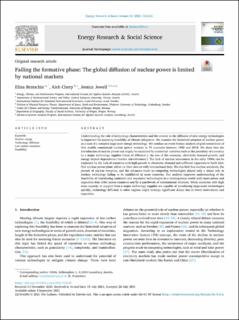| dc.contributor.author | Brutschin, Elina | |
| dc.contributor.author | Cherp, Aleh | |
| dc.contributor.author | Jewell, Jessica | |
| dc.date.accessioned | 2022-03-21T13:06:57Z | |
| dc.date.available | 2022-03-21T13:06:57Z | |
| dc.date.created | 2021-09-20T16:11:17Z | |
| dc.date.issued | 2021 | |
| dc.identifier.issn | 2214-6296 | |
| dc.identifier.uri | https://hdl.handle.net/11250/2986515 | |
| dc.description.abstract | Understanding the role of technology characteristics and the context in the diffusion of new energy technologies is important for assessing feasibility of climate mitigation. We examine the historical adoption of nuclear power as a case of a complex large scale energy technology. We conduct an event history analysis of grid connections of first sizable commercial nuclear power reactors in 79 countries between 1950 and 2018. We show that the introduction of nuclear power can largely be explained by contextual variables such as the proximity of a country to a major technology supplier (‘ease of diffusion’), the size of the economy, electricity demand growth, and energy import dependence (‘market attractiveness’). The lack of nuclear newcomers in the early 1990s can be explained by the lack of countries with high growth in electricity demand and sufficient capacities to build their first nuclear power plant, either on their own or with international help. We also find that nuclear accidents, the pursuit of nuclear weapons, and the advances made in competing technologies played only a minor role in nuclear technology failing to be established in more countries. Our analysis improves understanding of the feasibility of introducing contested and expensive technologies in a heterogenous world with motivations and capacities that differ across countries and by a patchwork of international relations. While countries with high state capacity or support from a major technology supplier are capable of introducing large-scale technologies quickly, technology diffusion to other regions might undergo significant delays due to lower motivations and capacities. | en_US |
| dc.language.iso | eng | en_US |
| dc.publisher | Elsevier | en_US |
| dc.rights | Navngivelse 4.0 Internasjonal | * |
| dc.rights.uri | http://creativecommons.org/licenses/by/4.0/deed.no | * |
| dc.title | Failing the formative phase: The global diffusion of nuclear power is limited by national markets | en_US |
| dc.type | Journal article | en_US |
| dc.type | Peer reviewed | en_US |
| dc.description.version | publishedVersion | en_US |
| dc.rights.holder | Copyright 2021 The Authors | en_US |
| dc.source.articlenumber | 102221 | en_US |
| cristin.ispublished | true | |
| cristin.fulltext | original | |
| cristin.qualitycode | 1 | |
| dc.identifier.doi | 10.1016/j.erss.2021.102221 | |
| dc.identifier.cristin | 1936234 | |
| dc.source.journal | Energy Research & Social Science | en_US |
| dc.relation.project | Norges forskningsråd: 267528 | en_US |
| dc.identifier.citation | Energy Research & Social Science. 2021, 80, 102221. | en_US |
| dc.source.volume | 80 | en_US |

